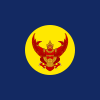Wongsa Dhiraj Snid
| Wongsa Dhiraj Snid วงศาธิราชสนิท | |||||
|---|---|---|---|---|---|
| Prince of Siam | |||||
 | |||||
| Born | 9 July 1808 Bangkok, Siam | ||||
| Died | 14 August 1871 (aged 63) Bangkok, Siam | ||||
| Issue | 52 Children | ||||
| |||||
| House | Chakri Dynasty | ||||
| Father | Buddha Loetla Nabhalai (Rama II) | ||||
| Mother | Prang Yai | ||||
Wongsa Dhiraj Snid (Thai: พระเจ้าบรมวงศ์เธอ กรมหลวงวงศาธิราชสนิท; 9 July 1808 – 14 August 1871) was a Thai physician and diplomat, as well as a member of the reigning Chakri dynasty. An early adopter of Western-style medicine, he was the for much of his life, and was known as the "Doctor Prince."
Early life and family[]

Wongsa Dhiraj Snid was born in 1808, the 49th son of King Rama II of Siam, and given the title of Phra Ong Chao Nawama.[1] His maternal grandparents were both traditional medical practitioners who served as during his father's reign. He was the half-brother of both Prince Thap, the future King Rama III, some twenty years his senior, and Prince Mongkut, the future King Rama IV.[2]
Following Thai tradition, Wongsa Dhiraj Snid spent much of his early life learning statecraft, administration, and Buddhist teachings. He was ordained as a Buddhist monk as a young man. During his time as a monk, he was mentored by an uncle, Paramanuchitchinorot, the future Supreme Patriarch of Thailand.[1] It is believed (though not known for certain) that he served an apprenticeship to learn traditional Thai medicine as well.[2]
Medical practice[]
Wongsa Dhiraj Snid followed the footsteps of his maternal family and became a physician, serving as the royal physician during the reigns of Rama III and Rama IV. He was first appointed chief of the Department of Royal Physicians at the age of 34.[1] Though he was trained in traditional Thai medicine, he quickly adopted more Western forms of practice. He compiled a textbook of Thai medicinal herbs in a scientific style, and was the first Thai physician to utilize quinine in the treatment of malaria. He was granted honorary membership by a number of medical societies in both Europe and the United States.[2]
Diplomacy and war[]
Wongsa Dhiraj Snid's court duties were not confined to the practice of medicine; he also served as a diplomat and even a field commander. During the Burmese–Siamese War (1849–55), he led the Siamese forces that attacked Kengtung in 1854.[3] He was one of the five Thai plenipotentiaries sent to negotiate the Bowring Treaty with the United Kingdom in 1855.[4] He was also among the signatories of the Harris Treaty between Siam and the United States the following year.[5]
Legacy[]

The descendants of Wongsa Dhiraj Snid took the name of Sanidwongse (sometimes spelled Sanidvongse, Snidvongs, or other variants). Several of his descendants, like him, served as royal physicians in Thailand.[1] On the 200th anniversary of his birth in 2008, he was honored by UNESCO as a "Great World Personality", the 17th Thai to be so honored,[6] and in 2009 he was featured on a Thai postage stamp.[2]
Among his notable descendants are Queen Sirikit and her son King Rama X of Thailand, along with several other members of the Thai royal family, and prominent surgeon Kalyanakit Kitiyakara.
References[]
- ^ a b c d Harper, Tim, Amrith, Sunil G. "Histories of Health in Southeast Asia" pp. 23-26
- ^ a b c d Steensma, David P., Viprakasit, Vip, Kyle, Robert A., and Shampo, Marc A. "Prince Wongsa Dhiraj Snid-Thai Physician and Diplomat" Mayo Clin Proc. 2012 Nov; 87(11): e93.
- ^ Bowring, Sir John (1857). The Kingdom and People of Siam; A Narrative of the Mission to that Country in 1855 (Vol II). London: John W Parker & Son. pp. 364–367. Retrieved 5 October 2018.
- ^ Tunku Prof Datuk Dr Sofiah Jewa (2018-01-18). "Preserving a special relationship". New Straits Times. Retrieved 5 October 2018.
- ^ "Treaties and Conventions Concluded Between the United States of America and Other Powers Since July 4, 1776" Government Printing Office
- ^ UNESCO Bangkok Newsletter pg. 7
- House of Sanidwong
- 1808 births
- 1871 deaths
- 19th-century Thai physicians
- Thai diplomats
- 19th-century Chakri dynasty
- Thai male Phra Ong Chao

